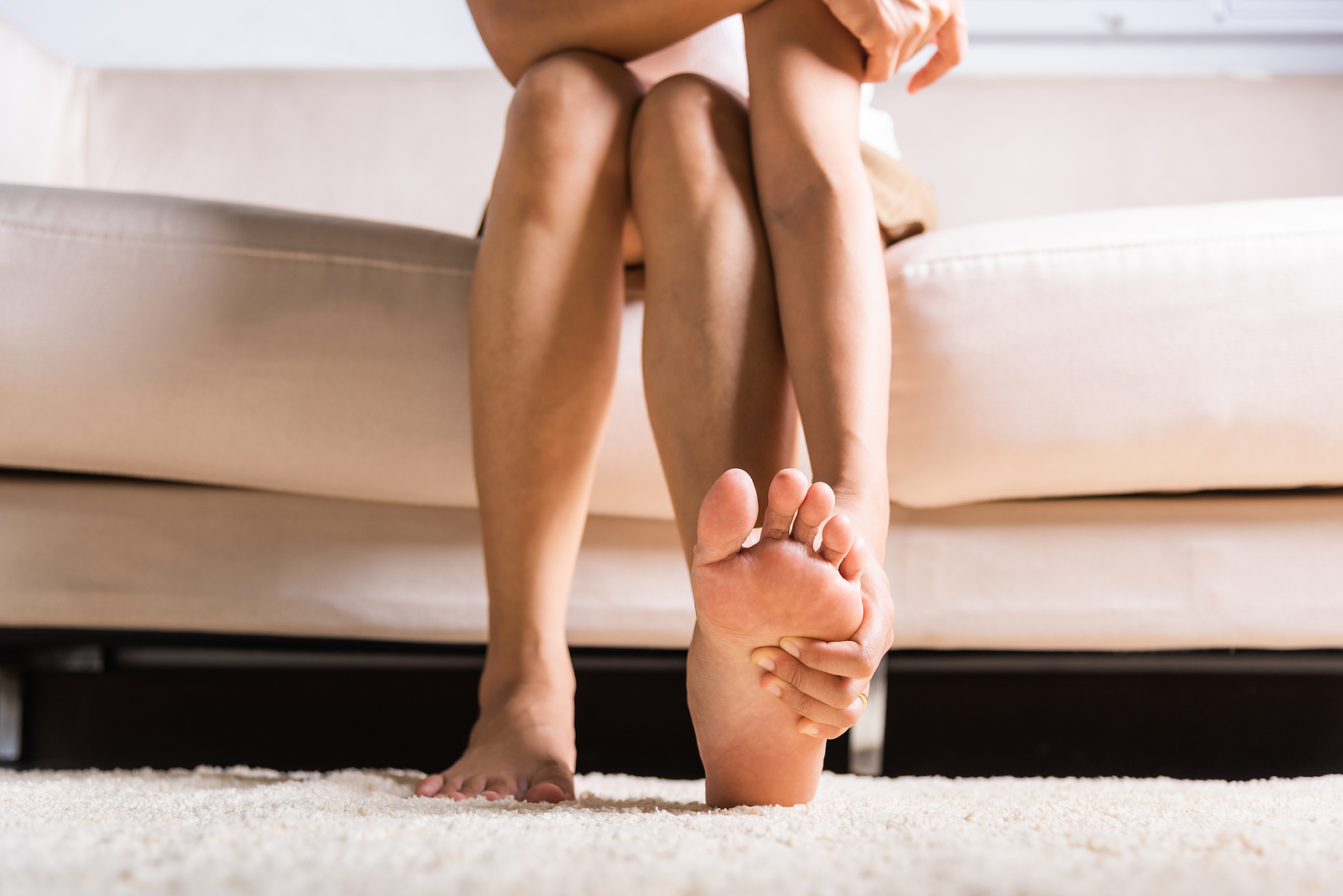
One of the most common reasons for heel pain is plantar fasciitis. Plantar fasciitis can affect anyone who walks frequently on hard surfaces. Plantar fasciitis is characterized by severe morning-time pain. Most of the time, the pain gets better when you stand up and walk. Still, it may come back if you stand for a long time or sit down and then stand up.
Although it may seem like inflammation, this condition is caused by tissue degeneration connecting your toes to your heel bone. People who run a lot, have flat feet or high arches, are overweight, or spend a lot of time on their feet often get plantar fasciitis. (OrthoInfo)
What Are The Common Symptoms Of Plantar Fasciitis?
The most common symptom is a soreness, which can be mild or severe. Patients also report pain on the bottom of the heel or in the surrounding area, which is usually exacerbated by exercise.
Many people say the pain is worse in the morning or after long periods of sitting. In terms of outward appearance, the most common condition is a swollen heel. If left untreated, this discomfort can last for months. (Cleveland Clinic)
What Causes Plantar Fasciitis?
Although the exact cause of plantar fasciitis in many cases is unknown, repeated stretching and tearing of the fascia (the connective tissue between the heel bone and the toes) can irritate or inflame it. Individuals with high-arched or flat feet are more likely to develop plantar fasciitis. Foot pain is common when people wear shoes that do not adequately support their feet, especially for long periods of time on a hard surface. Obese patients, athletes, and those with jobs that require long periods of standing may develop plantar fasciitis. (Mayo Clinic, 2022)
How Can You Treat Plantar Fasciitis with at-home remedies?
If the underlying cause of your plantar fasciitis is something you cannot control, such as a flat foot, permanent recovery is tough. It is advisable to continue to combat the symptoms with home remedies and physician-recommended treatments. While there are a few outpatient treatments available for critical cases, these at-home remedies help in healing better.
Cupped Heels
Every time you take a step, your heel hits the ground and this puts stress on your plantar fascia. These shoe inserts in the shape of heels might be helpful. They raise the heel to make it easier on the foot and give it more cushioning. They might not work as well as inserts all the time, but they’re economical and worth trying.
The Night Splints
Night splints hold your feet at a 90° angle while you sleep. The plantar fascia and Achilles tendons get shorter when we sleep with our feet pointed down. So, the plantar fascia gets a gentle, constant stretch while you sleep instead of being cut.
Even though they are big and heavy, they work very well. Once the pain has gone away, you can stop using them.
Shoes For Walking Or a Cast
When all other treatments have failed, a controlled ankle motion (CAM) walker, a walking cast, or a boot are often prescribed. The cast or CAM walker forces you to put your foot up and rest it, which may help ease the pain. It is not, however, a cure. When the cast comes off, the pain may come back. Because of this, you’ll need extra treatments like insoles and stretching.
Use Of Ice as Therapy
It is a simple way to treat inflammation, and it can be used in many different ways. To make an ice pack, wrap a towel around a bag of crushed ice or a frozen container of corn or peas. Apply it to your heel three to four times a day for 15 to 20 minutes each time.
You can also fill a shallow pan halfway with water and ice and soak your heel in it for 10 to 15 minutes several times a day. Never completely submerge your feet in the water.
Pain Killers
Nonsteroidal anti-inflammatory drugs (NSAIDs) can help relieve pain and swelling in the feet.
Stretching, And Working Out
Exercise can help stabilize your ankle, relieve pain, and keep you from getting plantar fasciitis again. Do exercises to build up the muscles in your feet and lower legs. You should stretch your calves, your Achilles tendon, and the bottoms of your feet. (Wheeler, 2021)
Just a Pain in the Foot
Plantar Faciitis requires continued care to manage the pain and symptoms. After a few months, most people with plantar fasciitis recover independently. It is advisable to get properly diagnosed by your physician in order to access the most effective remedies.
Works Cited:
OrthoInfo. “Plantar Fasciitis and Bone Spurs – Orthoinfo – Aaos.” OrthoInfo, orthoinfo.aaos.org/en/diseases–conditions/plantar-fasciitis-and-bone-spurs.
Wheeler, Tyler. “Plantar Fasciitis Home Remedies & Prevention: 15 Tips for Relief.” WebMD, WebMD, 22 Sept. 2021, www.webmd.com/fitness-exercise/what-can-i-do-plantar-fasciitis#1.
Mayo Clinic. “Plantar Fasciitis.” Mayo Clinic, Mayo Foundation for Medical Education and Research, 20 Jan. 2022, www.mayoclinic.org/diseases-conditions/plantar-fasciitis/symptoms-causes/syc-20354846.
Cleveland Clinic. “Plantar Fasciitis: Causes, Symptoms & Treatment.” Cleveland Clinic, my.clevelandclinic.org/health/diseases/14709-plantar-fasciitis.





